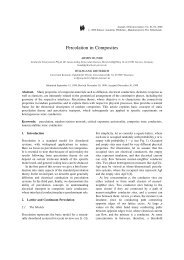Emplacement depths and radiometric ages of Paleozoic plutons of ...
Emplacement depths and radiometric ages of Paleozoic plutons of ...
Emplacement depths and radiometric ages of Paleozoic plutons of ...
You also want an ePaper? Increase the reach of your titles
YUMPU automatically turns print PDFs into web optimized ePapers that Google loves.
238<br />
ranging from 890 to 940 jC for Opx–Prg–Spl<br />
assembl<strong>ages</strong> (Vsˇeruby <strong>and</strong> Neukirchen olivine gabbro;<br />
Fig. 6D) <strong>and</strong> 810 to 920 jC for Opx–Cpx–Spl<br />
coronas (Hoher–Bogen olivine metagabbro; Fig. 6F).<br />
For these rocks, a pressure estimate is possible based<br />
on the reaction: Ol + Pl F H2O ! Opx + Am or Cpx +<br />
Spl. Such coronitic micr<strong>of</strong>abrics are typical features in<br />
olivine gabbros that underwent magmatic cooling or<br />
high-grade metamorphism at P =6.5–8 kbar (e.g.,<br />
Grantham et al., 1993; Jan <strong>and</strong> Karim, 1995). According<br />
to Bucher <strong>and</strong> Frey (1994), such micr<strong>of</strong>abrics are<br />
diagnostic for pressures >6 kbar. In Fig. 6D <strong>and</strong> F, the<br />
spinel-in reaction in the system CaO–MgO–Al2O3–<br />
SiO2 is illustrated according to Gasparik (1984). In<br />
natural systems containing iron (XMg = ca. 0.9), spinel<br />
may occur at some lower pressures (Bucher <strong>and</strong> Frey,<br />
1994).<br />
6. Radiometric dating<br />
For carrying out K–Ar age dating, biotite <strong>and</strong><br />
hornblende have been separated from samples <strong>of</strong> the<br />
Smrzˇovice <strong>and</strong> Teufelsberg intrusions. Light brown to<br />
greenish magnesio-hornblende sampled from finegrained<br />
hornblende–biotite diorite <strong>of</strong> the large Smrzˇovice<br />
quarry (sample SK 4, Location 2 in Fig. 1) shows<br />
weak alteration along the cleavage planes. Magnetic<br />
<strong>and</strong> unmagnetic fractions yield 547 F 7 <strong>and</strong> 549 F 7<br />
Ma, respectively (Table 2). Dark brown to reddish<br />
brown biotite separated from biotite–hornblende<br />
quartz diorite <strong>of</strong> the Smrzˇovice quarry (sample 113)<br />
shows few inclusions <strong>of</strong> plagioclase, ilmenite<br />
F hornblende. The degree <strong>of</strong> biotite alteration is<br />
very weak. In a few places, biotite is moderately<br />
altered to clinozoisite (along the cleavage planes)<br />
<strong>and</strong>/or chlorite at the margins. K–Ar dating <strong>of</strong> this<br />
biotite yields 495 F 6 Ma (Table 2).<br />
K–Ar dating <strong>of</strong> biotite <strong>of</strong> the Teufelsberg pyroxene<br />
diorite (Location 7 in Fig. 1) yields 342 F 4 Ma.<br />
Similar to the Smrzˇovice samples, the Teufelsberg<br />
biotite is relatively fresh. Rare alteration in form <strong>of</strong><br />
weak chloritization is restricted to the marginal parts.<br />
The separated zircons <strong>of</strong> the Teufelsberg diorite<br />
(Location 7 in Fig. 1) are colourless <strong>and</strong> yellow<br />
belonging to the subtypes S20 to S25 <strong>and</strong> J1 to J5<br />
according to the classification <strong>of</strong> Pupin (1980). The<br />
internal structure <strong>of</strong> the zircons is perceptible in<br />
C. Bues et al. / Tectonophysics 352 (2002) 225–243<br />
cathodoluminescence (CL) im<strong>ages</strong> oriented parallel<br />
to the zircon c-axis. The different light–dark contrasts<br />
<strong>and</strong> bright color display different amounts <strong>of</strong> trace<br />
element content. The bright color represents more or<br />
less pure zircon phase, whereas the different dark<br />
colors reflect variable amount <strong>of</strong> U <strong>and</strong> Y contents.<br />
The internal structure <strong>of</strong> all zircons is complex (e.g.,<br />
Fig. 7). A rounded heterogeneous core is surrounded<br />
by a thin discordant bright zone (A in Fig. 7), the<br />
latter suggesting a first stage <strong>of</strong> dissolution. A narrowspaced<br />
oscillatory zoning follows combined with<br />
compositional sector zoning between dark prisms<br />
<strong>and</strong> light–dark 101-pyramides until a second stage<br />
<strong>of</strong> dissolution is indicated by a thin discordant bright<br />
zone (B in Fig. 7). Towards the margin, a similar<br />
combination follows including small light–dark 211pyramids<br />
ceasing with a third stage <strong>of</strong> dissolution<br />
indicated by a thick discordant bright zone (C in Fig.<br />
7). The margin <strong>of</strong> the zircon consists <strong>of</strong> dark prisms<br />
<strong>and</strong> pyramids.<br />
The single zircons have a weight <strong>of</strong> 37–41 Ag <strong>and</strong><br />
thus, a total lead from 513 to 998 pg, resulting in high<br />
beam intensities <strong>and</strong> allowing static-mode measurements<br />
in all cases. The concordant single zircon 1 <strong>and</strong><br />
four discordant single zircons 2 to 5 define a discordia<br />
with an upper intercept at 361 F 4 Ma <strong>and</strong> a lower<br />
intercept at 16 F 12 Ma (Fig. 8F, Table 3). These data,<br />
together with the age <strong>of</strong> a concordant zircon at<br />
359 F 2 Ma, are interpreted to reflect the age <strong>of</strong> the<br />
zircon crystallization <strong>and</strong> thus, the magmatic emplacement<br />
age <strong>of</strong> the Teufelsberg diorite. Although the CL<br />
im<strong>ages</strong> show a complex core pattern in the zircons, no<br />
inherited lead could be detected (Table 3).<br />
7. Discussion <strong>and</strong> conclusions<br />
The Vsˇepadly granodiorite <strong>and</strong> the Smrzˇovice<br />
diorite <strong>of</strong> the NE part <strong>of</strong> the NKM intruded at shallow<br />
crustal levels (< 7 km depth) as is indicated by Al-in-<br />
Hbl barometry. Similar emplacement <strong>depths</strong> have<br />
been determined for the Těsovice granite <strong>of</strong> the<br />
adjacent Stod pluton (Zulauf et al., 1997). A supracrustal<br />
emplacement level is also indicated by the<br />
small differences between U–Pb zircon <strong>ages</strong> (that<br />
reflect the time <strong>of</strong> pluton emplacement) <strong>and</strong> K–Ar<br />
<strong>and</strong> Ar–Ar <strong>ages</strong> <strong>of</strong> hornblende <strong>and</strong> mica (that reflect<br />
cooling <strong>of</strong> the pluton through particular isotherms).



